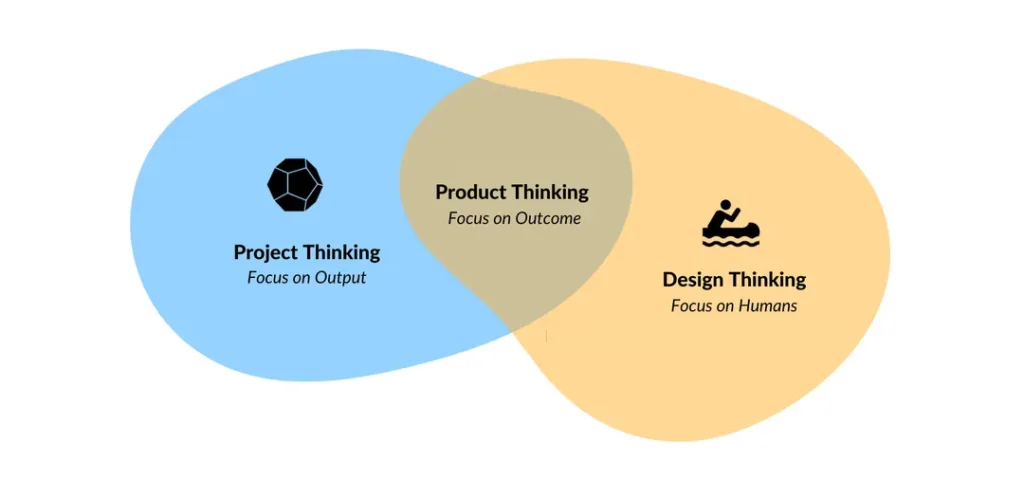Product Thinking: The Mindset Driving Successful Products
Product thinking is emerging as a crucial skill for building great digital products in the modern technology landscape. With consumers demanding exceptional digital experiences, having a product-focused mindset can give companies an edge. This article explores what product thinking encompasses, why it matters, and how organisations can nurture it.
Table of Contents
What Exactly is Product Thinking?
Product thinking is a mindset that puts the product at the heart of technology strategy and decision-making. It involves having an intuitive understanding of the product, users' needs, the market landscape, and business objectives. Product thinkers have a user-centric perspective, a vision for the product experience, and a passion for bringing ideas to life.

Critical Aspects of Product Thinking
Product thinking encompasses several interrelated aspects:
- User Empathy – Deeply understanding users' needs, pain points, and desires regarding a product. Product thinkers advocate for the user throughout the product development process.
- Product Vision – Having a clear strategic vision for the product aligned with company goals and user needs. This shapes a compelling product story.
- Business Sense – Grasping business objectives like growth, revenue, and profitability goals. Product decisions balance user needs with business viability.
- Technical Know-How – Understanding technical possibilities, limitations, and tradeoffs to inform product decisions. There is no need to be able to code, but technological literacy helps.
- Design Orientation – Valuing simple, intuitive, and cohesive product experiences based on design principles and paying attention to aesthetics and micro-interactions.
- Research Focus – Making product decisions and choices backed by qualitative and quantitative data via research, relying on facts over hunches or gut feeling alone.
- Iteration Mindset – Viewing product building as an iterative process based on continuously learning from users and the market, being comfortable with constant change.
With these well-developed aspects, product thinkers guide products to success.
- R. Dutt (Author)
- English (Publication Language)
- 216 Pages – 09/28/2021 (Publication Date) – Berrett-Koehler Publishers (Publisher)
The Goals of Product Thinking
Product thinkers aim to:
- Deeply understand target users and what delights them
- Identify market opportunities and customer pain points
- Envision solutions that solve real problems for real people
- Continuously experiment, learn, and improve product-market fit
The critical goals of product thinking include:
- Building products that customers love and meaningfully improve lives
- Creating excellent user experiences that drive adoption and retention
- Shipping high-quality products quickly in an iterative fashion
- Generating business value by increasing critical metrics like revenue, engagement, and growth
Ultimately, product thinking focuses on the customer first and obsesses about their needs, goals, behaviours, and jobs to be done. This leads to human-centred products that provide tangible value.
Why Product Thinking Matters More Than Ever

Several key factors make product thinking an indispensable skill in today's digital landscape:
The Experience Economy Has Arrived
We live firmly in the “experience economy” era, where digital products must deliver outstanding end-to-end experiences to delight users. Product quality and polish matter more than ever. Companies need product thinkers to craft these seamless experiences.
Fierce Competition Everywhere
Burgeoning competition exists across almost all digital product categories like apps, software, devices, and platforms. Strong product thinking helps companies differentiate themselves. It enables them to understand users deeply and create products tailored to their needs.
Rapid Pace of Technology Innovation
Technology keeps advancing at a blazing pace, bringing new possibilities and complexity. Companies need product thinkers who grasp technical potential but stay grounded in user needs to harness this innovation and complexity.
Demand for Constant Iteration
The market demands rapid iteration of digital products based on user data and feedback. Product thinkers recognise this imperative to evolve products using an iterative, user-driven approach constantly.
With these realities now universal, product thinking matters more than ever. Companies need product thinkers leading product development to succeed in crowded, dynamic, experience-driven markets.
Core Responsibilities of a Product Thinker
Product thinkers play a hybrid role, combining different responsibilities:
- Lead overall product strategy – define product vision and high-level game plan
- Conduct user research – gain qualitative insights about user needs
- Perform data analysis – extract user needs and market trends from data
- Translate research into product requirements – capture essential user workflows/jobs-to-be-done
- Prioritise and shape product roadmap – sequence implementation to balance user value, development effort, and business goals.
- Drive product design – specify user flows, wireframes, prototypes
- Guide technical development – ensure alignment with product direction
- Coordinate effective launch – drive marketing messaging, sales enablement, etc.
- Monitor product success metrics – track critical indicators of business and user impact.
- Champion continuous iteration – use feedback and data to guide ongoing improvements
This wide-ranging role draws on diverse skills – strategic thinking, user empathy, data literacy, design orientation, and technical communication. Top-notch product thinkers master the blend of capabilities needed to excel.
Traits of Effective Product Thinkers

What behaviours and qualities set great product thinkers apart? Based on patterns observed, these characteristics consistently emerge:
User Advocates
- Live and breathe users – obsessed with understanding user needs
- Doubt solutions lacking user validation
- Relentless user focus but also grasp business realities
Intentional Learners
- Insatiably curious – constantly questioning and researching
- Embrace uncertainty – comfortable not having all the answers
- Evidence-driven – letting data and research guide decisions
Systems Thinkers
- Firm grasp of connections between parts of a product
- Anticipate downstream impacts of upstream product changes
Inspirational Leaders
- Rally people around a compelling product vision
- Instill a sense of purpose and priority in teams
- Encourage by example – dogfooding products, user research
Comfortable with Change
- View product development as a continuum, not a destination
- Receptive to changing course based on user feedback
- Willingness to iterate, experiment, take risks
Business & Technical Bilinguals
- Fluent in user needs but also business numbers
- Grasp technical landscape and tradeoffs but stay anchored in user jobs-to-be-done
Cultivating these behaviours helps product thinkers thrive.
- Audible Audiobook
- David H. DeWolf (Author) – David H. DeWolf, Jessica S. Hall (Narrators)
- English (Publication Language)
- 08/30/2019 (Publication Date) – Lioncrest Publishing (Publisher)
Best Practices for Nurturing Product Thinkers
How can companies nurture more people and teams with solid product thinking? Some proven approaches:
Make User Data Ubiquitous
- Embed usage analytics tools product-wide
- Build user research repository – store findings centrally
- Democratise data access – don't silo insights
- Promote data literacy – educate teams on working with data
Preach User Focus
- Set user-centric OKRs derived from research
- Require every product proposal to include user problems and validation
- Share compelling user stories and verbatims across the company
- Show examples linking product changes to user feedback
Provide Method Training
- Offer courses in Lean and Design Thinking
- Conduct hands-on workshops focused on product skills like interviewing, prototyping, usability testing
- Develop frameworks capturing best practices
Build Tensions
- Constructively debate solutions in meetings
- Play devil's advocate – argue alternative interpretations of data; user needs
- Be transparent on success metrics but flexible on solutions
- Challenging ideas leads to better outcomes
Encourage Cross-functional Collaboration
- Include people across functions – engineering, design, product, and marketing – in crucial user studies and planning activities.
- Build hybrid roles like product designer that bridge disciplines
- Co-locate teams when possible
Lead by Example
- Execs must make user research and data central to their decision-making
- Leaders should exhibit key behaviours – user advocacy and evidence-based choices.
- Spotlight teams/individuals demonstrating strong product thinking
Making product thinking ubiquitous pays dividends in the form of flourishing, differentiated products.
Pitfalls to Avoid with Product Thinking

While powerful, product thinking has risks if not wielded carefully. Teams should sidestep these pitfalls:
Designing for Oneself
When product thinkers assume “I am the user”, solutions cater to personal preferences rather than user needs. Avoid relentlessly seeking broad user perspectives.
The HiPPO Trap
HiPPO stands for “Highest Paid Person's Opinion” – making decisions based on executive edicts versus user data—counter by democratising data access and requiring research to back proposals.
Misusing Data
Metrics give incomplete pictures without the “why” behind numbers. Combine quantitative data with qualitative insights from research. Don't let data drive products astray from meeting user needs.
Oversimplifying Users
Categorising users into restrictive personas can pigeonhole thinking. Seek diversity of user inputs to avoid one-dimensional perspectives.
Neglecting Accessibility
Failing to consider those with disabilities or access limitations excludes segments from using products. Build inclusive mindsets through exposure to diverse users.
Valuing Potential Over Problem
For technology's sake, cool technology won't necessarily solve real user problems. Ground ideas in concrete user needs, not just technological possibility.
Forewarned is forearmed against these pitfalls!
- Lewrick, Michael (Author)
- English (Publication Language)
- 345 Pages – 03/09/2022 (Publication Date) – John Wiley & Sons Inc (Publisher)
Measuring Product Thinking Impact
Quantifying the impact of product thinking helps justify investment and improve approaches over time. Valuable metrics to track include:
User Value Metrics
How does the product deliver value for users?
- User satisfaction score
- Net Promoter Score
- Engagement metrics like DAU/WAU for mobile apps
- Support ticket volume
- User Feedback
Business Value Metrics
What is the product's business impact?
- Revenue growth %
- Sales cycle time
- Conversion rates across funnels
- Lowered customer acquisition costs
- Increased retention rates
Team Impact Metrics
How has product thinking changed team dynamics?
- Number of user interviews conducted
- Hours spent actively user testing
- Number of concepts prototyped
- User data shared across functions
- Cross-functional participation in planning
Individual Capability Metrics
Have unique skills advanced?
- Employees passing product certifications.
- Employee NPS/engagement scores
- Self-assessed talent benchmarks
Process Change Metrics
How have processes progressed?
- User research integrated into the development process
- Data-driven prioritisation of roadmaps
- New frameworks adopted (e.g. Jobs To Be Done)
Tracking metrics across categories comprehensively shows product thinking's evolution and outcomes.
Key Models in Product Thinking
Several fundamental models provide frameworks for product thinkers to structure and drive product discovery, delivery, and growth. Common models include:
Opportunity Assessment Models
- Jobs-to-Be-Done – Defines the underlying process customers are trying to achieve and the functional, social, and emotional dimensions involved. Enables insights on paradigms like “hire” and “fire” moments.
- Market Opportunity Analysis – Examines market landscape, customer segments, use cases, buyer personas, served/underserved needs, jobs-to-be-done, and serviceable addressable market size—grounds opportunities in data.
- Competitive Landscape Analysis – Analyzes strengths and weaknesses of competitors, market categories, business models, GTM strategies, and product offerings. Highlights gaps and risks.
Execution Models
- Lean Startup Method – Focuses on ideating MVPs, rapid build-measure-learn iteration fueled by customer feedback, and evidence-based decisions about product-market fit before scaling. Accelerates learning.
- Dual Track Agile – Separates discovery and delivery workstreams to enable continuous exploration without slowing production releases. Aligns with Agile rituals like sprints and standups.
- Outcome-Based Roadmapping – Roadmaps solutions and release plans oriented around driving critical customer and business outcomes vs. outputs like features. Maintains alignment to vision.
Case Study: How Peloton Cultivated Product Thinkers

At-home fitness company Peloton provides an instructive case study in instilling product thinking across the organisation. Peloton is known for its category-leading exercise bikes/treadmills and digital classes, delivering a premium user experience.
Here are vital ways Peloton fostered product excellence company-wide:
Leaders as Chief Users
Peloton's executives, including CEO John Foley, use the product religiously. Their firsthand user perspective informs decisions.
Interdisciplinary Teams
Engineers collaborate closely with instructors on technology and content innovations, while designers focus on end-user needs.
Continuous User Feedback Loops
Peloton members provide extensive feedback fueling rapid iteration cycles. The company releases updated hardware, software, and classes constantly.
Ongoing Skills Training
Peloton provides boot camps to employees on skills like design thinking, customer journey mapping, and raising overall product/user IQ.
Laser Focus on Delighting Users
Customer support teams fix issues quickly, surprising users with care packages if deliveries fall short of expectations. The user is always right.
With fanatical attention to satisfying users, Peloton offers an inspirational blueprint for product excellence through people and processes.
Predictions for the Future of Product Thinking
Several trends will shape product thinking over the next five years:
- A Seat at the Executive Table – The product's strategic value will be recognised more, giving product leaders increased influence over company direction sitting alongside CEOs and CFOs.
- Rising Importance of Discover Research – There will be more significant investments in the upfront discovery of customer needs and product opportunities to de-risk development costs and enhance product-market fit likelihood before building.
- Agile and Lean Ubiquity – Agile, lean, and customer-driven development will become mandatory as the days of monolithic, multi-year releases are over. MVP iteration is the new normal.
- Platform-First Approaches – Companies will orient product portfolios around flexible platforms, APIs, cloud services, and developer ecosystems rather than just standalone applications to boost productivity.
- Mainstreaming of Jobs-To-Be-Done – Jobs-to-be-done will eclipse demographics and buyer personas as the dominant framework for uncovering the deeper motivations and hiring criteria guiding customer purchase decisions.
- Internal Coaching Mandates – More product managers will coach executives, sales teams, marketing staff, and support agents on customer perspectives to propagate empathy and outside thinking.
- Rapid Concept Testing – Products will test bolder concepts earlier with customers using realistic interactive prototypes, not just static mockups. This fails fast, learns faster, and doubles down on what resonates.
- Curiosity Focus – Curiosity will be nurtured as a core cultural value and competency within product teams to separate great and good product thinkers. Curiosity expands possibilities.
Product thinking will continue advancing as the critical driver of human-centred products that balance business value and delightful customer experiences. Companies investing in product capability will have the edge.
Conclusion
In today's crammed digital marketplace, product thinking gives companies an edge by ensuring close alignment between user desires and product experiences. Product thinkers blend strategic orientation, user empathy, technical literacy and business savvy to craft differentiated solutions. By democratising access to user data, promoting cross-functional collaboration, and developing critical skills across the organisation, companies can nurture product thinking to drive enduring product market fit and user delight.
Frequently Asked Questions
How technical do product thinkers need to be?
Deep technical skills like coding aren't required, but comfort in grasping technical concepts helps product thinkers discuss tradeoffs with engineers and guide development.
What backgrounds make good product thinkers?
Varied experience in design, engineering and marketing breeds strong product thinkers, but specialised training is also valuable. Cognitive empathy and curiosity are crucial.
How large should a product team be to benefit from this approach?
Small startups can be agile in adopting product thinking, but larger companies have more data and people to leverage. The key is executive buy-in.
How can companies align roles like UX designers into a product thinking model?
Integrate them into cross-functional squads focused on specific product areas. Build T-shaped skills. Provide training in product methods.
Which metrics are most important for assessing product thinking ROI?
User satisfaction scores, conversion funnel metrics, retention rates, and revenue growth % indicate how product thinking influences user and business value.
Last update on 2024-04-27 / Affiliate links / Images from Amazon Product Advertising API



